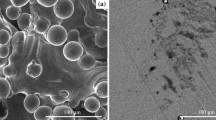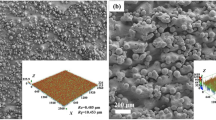Abstract
In this work, we investigate the effect of additive manufacturing parameters on the corrosion resistance of AISI 316L stainless steel used to fabricate orthopedic implants. Samples were produced by selective laser melting, where the volumetric energy density, controlled by process parameters, was varied from 19 J/mm3 to 167 J/mm3. A scanning electron microscope reveals that the increase of the volumetric energy density improves the material continuities by reducing the fraction of porosities from 54 to 0.3% and changing their morphologies from large pores with an irregular elongated shape to small size spherical shape. This beneficial effect is related to a reduction of parts roughness which varies from 5 to 12 µm. A Physical Vapor Deposited (PVD) TiN coating was applied to the manufactured parts to reduce surface roughness and to close porosities. Corrosion tests were carried out in Ringer’s solution at 37 °C, corresponding to normal human biological temperature. It has been proved that increasing the volume energy density enhances corrosion resistance considerably and the pitting of additive manufactured parts. The application of PVD TiN coating provides additional protection against physiologic corrosion. The protective layer has successfully increased the corrosion potential Ecorr, reduced pitting corrosion, and improved the corrosion rate significantly. These results allow prosthesis manufacturers to extend the service life of prostheses obtained by additive manufacturing and subjected to physiological corrosion.












Similar content being viewed by others
References
Lodhi MJK, Deen KM, Greenlee-Wacker MC, Waseem H (2019) Additively manufactured 316L stainless steel with improved corrosion resistance and biological response for biomedical applications. Addit Manuf 27:8–19. https://doi.org/10.1016/j.addma.2019.02.005
Al-Mamun N, Deen KM, Haider W, Asselin E, Shabib I (2020) Corrosion behavior and biocompatibility of additively manufactured 316L stainless steel in a physiological environment: The effect of citrate ions. Additive Manuf 34:101237. https://doi.org/10.1016/j.addma.2020.101237
Yahyaoui H, Ben Moussa N, Braham C, Ben Fredj N, Sidhom H (2014) Role of machining defects and residual stress on the AISI 304 fatigue crack nucleation. Fatigue Fract Eng Mater Struct 38:420–433. https://doi.org/10.1111/ffe.12243
Ben Moussa N, Sidhom H, Braham C (2012) Numerical and experimental analysis of residual stress and plastic strain distributions in machined stainless steel. Int J Mech Sci 64(1):82–93. https://doi.org/10.1016/j.ijmecsci.2012.07.011
Naoufel BM, Khouloud G, Iheb C, Nabil BF (2019) Improvement of AISI 304 austenitic stainless steel low-cycle fatigue life by initial and intermittent deep rolling. Int J Adv Manuf Technol 101(1):435–449. https://doi.org/10.1007/s00170-018-2955-0
Li Y, Ding S, Wen C (2019) Additive manufacturing technology for porous metal implant applications and triple minimal surface structures: a review. Bioactive Materials 4:56–70. https://doi.org/10.1016/j.bioactmat.2018.12.003
Kong D, Dong C, Ni X, Li X (2019) Corrosion of metallic materials fabricated by selective laser melting. Mater Degradation 3(1):24. https://doi.org/10.1038/s41529-019-0086-1
Mohd YS, Yifei C, Richard B, Shoufeng Y, Nong G (2017) Investigation on porosity and microhardness of 316L stainless steel fabricated by selective laser melting. Metals 7(2):64. https://doi.org/10.3390/met7020064
Francesco A, Alex L, Emanuele V, Giovanni T, Marco S, Lorenzo F (2019) Corrosion behaviour of 316L stainless steel manufactured by selective laser melting. Mater Corros 70(9):1633–1645. https://doi.org/10.1002/maco.201910792
Josef H, Martin K, Jiri H, Marek P, Jana P, Zbigniew B, Tomasz T (2020) Complex corrosion properties of AISI 316L steel prepared by 3D printing technology for possible implant applications. Materials 13(7):1527. https://doi.org/10.3390/ma13071527
HemmasianEttefagh A, Guo S, Raush J (2021) Corrosion performance of additively manufactured stainless steel parts: a review. Additive Manuf 37:101689. https://doi.org/10.1016/j.addma.2020.101689
Woźniak A, Adamiak M, Chladek G, Kasperski J (2020) The influence of the process parameters on the microstructure and properties SLM processed 316L stainless steel. Arch Metall Mater 65:73–80. https://doi.org/10.24425/amm.2019.131098
Cherry JA, Davies HM, Mehmood S, Lavery NP, Brown SGR, Sienz J (2015) Investigation into the effect of process parameters on microstructural and physical properties of 316L stainless steel parts by selective laser melting. Int J Adv Manuf Technol 76(5):869–879. https://doi.org/10.1007/s00170-014-6297-2
Erica L, Stefania T, Lorella C, Alessandro F (2017) Effect of selective laser melting (SLM) process parameters on microstructure and mechanical properties of 316L austenitic stainless steel. J Mater Process Technol 249:255–263. https://doi.org/10.1016/j.jmatprotec.2017.05.042
Yahyaoui H, Ben Moussa N, Habibi M, Ghanem F, and Ben Salah N (2022) Effect of additive manufacturing parameters on 316L SS surfaces characteristics, in Advances in Mechanical Engineering and Mechanics IISpringer International Publishing: Tunisie. 211–216..
Pratik M, Somayeh P, Burkan IO (2019) Production of corrosion-resistant 316L stainless steel clads on carbon steel using powder bed fusion-selective laser melting. J Mater Process Technol 273:116243. https://doi.org/10.1016/j.jmatprotec.2019.05.024
Lin Kaijie Gu, Dongdong XL, Luhao Y, Songqiao N, Pei Lv, Qing Ge (2019) Selective laser melting processing of 316L stainless steel: effect of microstructural differences along building direction on corrosion behavior. Int J Adv Manuf Technol 104(5):2669–2679. https://doi.org/10.1007/s00170-019-04136-9
Sander G, Thomas S, Cruz V, Jurg M, Birbilis N, Gao X, Brameld M, Hutchinson CR (2017) On the corrosion and metastable pitting characteristics of 316L stainless steel produced by selective laser melting. J Electrochem Soc 164(6):C250–C257. https://doi.org/10.1149/2.0551706jes
Cem Ö (2018) Additive manufacturing–a general corrosion perspective. Corrosion Eng, Sci Technol 53(7):531–535. https://doi.org/10.1080/1478422X.2018.1511327
Gharbi K, Ben Moussa N, Ben Rhouma A, Ben Fredj N (2021) Improvement of the corrosion behavior of AISI 304L stainless steel by deep rolling treatment under cryogenic cooling. Int J Adv Manuf Technol 117:1–17. https://doi.org/10.1007/s00170-021-07744-6
Zandi ZR, Verbeken K, Adriaens A (2011) The corrosion resistance of 316L stainless steel coated with a silane hybrid nanocomposite coating. Prog Org Coat 72(4):709–715. https://doi.org/10.1016/j.porgcoat.2011.08.001
Cieślik M, Engvall K, Pan J, Kotarba A (2011) Silane–parylene coating for improving corrosion resistance of stainless steel 316L implant material. Corros Sci 53(1):296–301. https://doi.org/10.1016/j.corsci.2010.09.034
Masalski J, Gluszek J, Zabrzeski J, Nitsch K, Gluszek P (1999) Improvement in corrosion resistance of the 316l stainless steel by means of Al2O3 coatings deposited by the sol-gel method. Thin Solid Films 349(1):186–190. https://doi.org/10.1016/S0040-6090(99)00230-8
Greco S, Gutzeit K, Hotz H, Kirsch B, Aurich JC (2020) Selective laser melting (SLM) of AISI 316L—impact of laser power, layer thickness, and hatch spacing on roughness, density, and microhardness at constant input energy density. Int J Adv Manuf Technol 108(5):1551–1562. https://doi.org/10.1007/s00170-020-05510-8
Saeidi K, Gao X, Zhong Y, Shen ZJ (2015) Hardened austenite steel with columnar sub-grain structure formed by laser melting. Mater Sci Eng, A 625:221–229. https://doi.org/10.1016/j.msea.2014.12.018
Tucho WM, Cuvillier P, Sjolyst-Kverneland A, Hansen V (2017) Microstructure and hardness studies of Inconel 718 manufactured by selective laser melting before and after solution heat treatment. Mater Sci Eng, A 689:220–232. https://doi.org/10.1016/j.msea.2017.02.062
Zuback JS, DebRoy T (2018) The hardness of additively manufactured alloys. Materials 11:2070. https://doi.org/10.3390/ma11112070
Yasa E, Kruth JP (2011) Microstructural investigation of selective laser melting 316L stainless steel parts exposed to laser re-melting. Procedia Eng 19:389–395. https://doi.org/10.1016/j.proeng.2011.11.130
Kluczyński J, Śnieżek L, Grzelak K, Mierzyński J (2018) The influence of exposure energy density on porosity and microhardness of the SLM additive manufactured elements. Materials 11(11):2304. https://doi.org/10.3390/ma11112304
Sun Y, Moroz A, Alrbaey KJ (2014) Sliding wear characteristics and corrosion behaviour of selective laser melted 316L stainless steel. J Mater Eng Perform 23(2):518–526. https://doi.org/10.1007/s11665-013-0784-8
Author information
Authors and Affiliations
Contributions
All authors contributed to the study conception and design. Material preparation, data collection and analysis were performed by Houda Yahyaoui, Naoufel Ben Moussa, Mohamed Habibi, Farhat Ghanem, and Nizar Ben Salah. The first draft of the manuscript was written by Houda Yahyaoui, and all authors commented on previous versions of the manuscript. All authors read and approved the final manuscript.
Corresponding author
Ethics declarations
Conflict of interest
The authors declare no competing interests.
Additional information
Publisher's note
Springer Nature remains neutral with regard to jurisdictional claims in published maps and institutional affiliations.
Rights and permissions
Springer Nature or its licensor (e.g. a society or other partner) holds exclusive rights to this article under a publishing agreement with the author(s) or other rightsholder(s); author self-archiving of the accepted manuscript version of this article is solely governed by the terms of such publishing agreement and applicable law.
About this article
Cite this article
Yahyaoui, H., Ben Moussa, N., Habibi, M. et al. Improvement of corrosion resistance of additive manufactured AISI 316L stainless steel in a physiological environment by TiN surface coating. Int J Adv Manuf Technol 125, 2379–2391 (2023). https://doi.org/10.1007/s00170-023-10879-3
Received:
Accepted:
Published:
Issue Date:
DOI: https://doi.org/10.1007/s00170-023-10879-3




